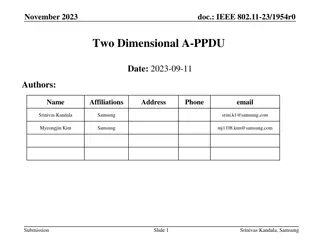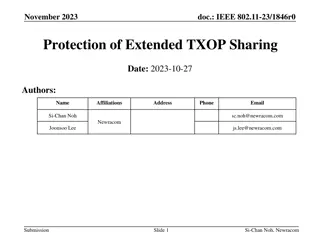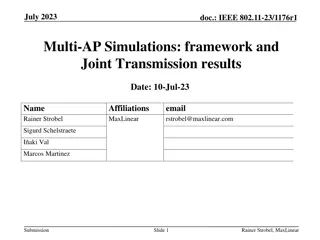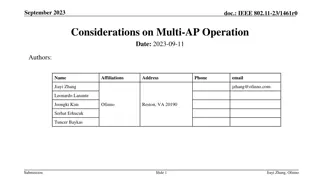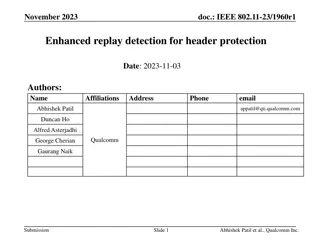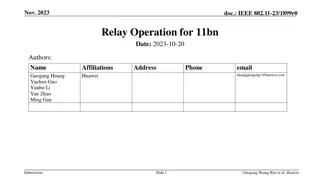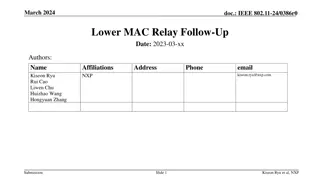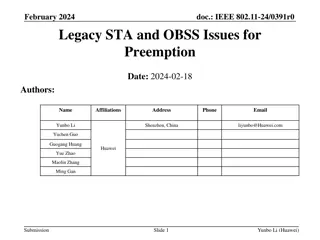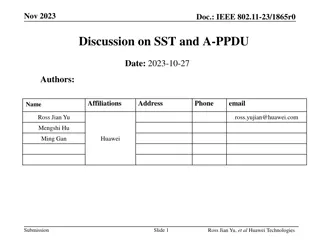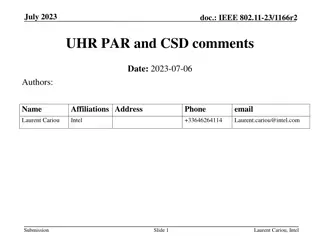Enhanced Security Considerations in IEEE 802.11-23 for UHR
The document discusses enhanced security considerations for control frames and MAC headers in IEEE 802.11-23 addressing vulnerabilities and proposing encryption/decryption methods. It highlights the need for support for security protocols in control frames and the importance of protecting MAC header fields to prevent unauthorized modifications. The current security methods are evaluated, suggesting improvements for confidentiality and integrity in UHR environments.
Download Presentation

Please find below an Image/Link to download the presentation.
The content on the website is provided AS IS for your information and personal use only. It may not be sold, licensed, or shared on other websites without obtaining consent from the author.If you encounter any issues during the download, it is possible that the publisher has removed the file from their server.
You are allowed to download the files provided on this website for personal or commercial use, subject to the condition that they are used lawfully. All files are the property of their respective owners.
The content on the website is provided AS IS for your information and personal use only. It may not be sold, licensed, or shared on other websites without obtaining consent from the author.
E N D
Presentation Transcript
November 2023 doc.: IEEE 802.11-23/1914r2 Enhanced Security Considerations in UHR Date: 2023-11-12 Authors: Name Affiliation Address Phone Email SunHee Baek Insun Jang Jinsoo Choi Yelin Yoon Geonhwan Kim Dongju Cha Eunsung Park Dongguk Lim Jinyoung Chun Insik Jung HanGyu Cho sunhee.baek@lge.com insun.jang@lge.com js.choi@lge.com yl.yoon@lge.com geonhwan.kim@lge.com dongju.cha@lge.com 19, Yangjae-daero 11gil, Seocho-gu, Seoul 137- 130, Korea esung.park@lge.com LG Electronics dongguk.lim@lge.com jiny.chun@lge.com insik0618.jung@lge.com hg.cho@lge.com 10225 Willow Creek Rd, San Diego, CA, USA Sanggook Kim sanggook.kim@lge.com Submission Slide 1 SunHee Baek, LG Electronics
November 2023 doc.: IEEE 802.11-23/1914r2 Introduction Current security definition is applied only to the data frame and management frame. So, the control frame doesn t support security method by setting reserved on the Protected Frame subfield in the Frame Control field. However, the particular types of control frame, Trigger frame and (Multi-)BlockAck, are needed to support security protocol, [1] ~ [3], because of the importance of this information. On current RSNA confidentiality and integrity protocols(CCMP, BIP, GCMP), receiver STA uses AAD to check integrity of MAC header in received frame. However, the current AAD construction doesn t include all (sub)fields of MAC header, which means the (sub)fields not included in the AAD are vulnerable to be modified by the third STA [4]. In this contribution, we share considerations of enhanced security methods for control frame and MAC header in UHR. Submission Slide 2 SunHee Baek, LG Electronics
November 2023 doc.: IEEE 802.11-23/1914r2 Background In the current baseline, RSNA security protocol has following types; Encryption/Decryption method (e.g., CCMP, GCMP) Only Integrity Check method (e.g., BIP) The Encryption/Decryption method(CCMP/GCMP) is used for data frame through PTK or GTK. In the result of CCMP/GCMP, values of Key ID and PN are located within CCMP/GCMP header and the value of MIC is located before FCS. The Integrity Check method(BIP) is used for management frame including Beacon frame through IGTK or BIGTK. In the result of BIP, values of Key ID, IPN/BIPN, and MIC within MME(Management MIC element) are included at the end of management frame body without encryption/decryption. There are two possible methods to protect the control frame by extending current security methods of the baseline. Submission Slide 3 SunHee Baek, LG Electronics
November 2023 doc.: IEEE 802.11-23/1914r2 Encryption/Decryption for Control frame Encryption/Decryption method is to prevent to decode the frame body from the 3rd STA, which is the most powerful protection method of the baseline. For example, if the control frame encrypts Common Info field and User Info List field of the Trigger frame, the Protected Frame subfield in Frame Control field will be set to 1. However, only UHR STA can decode the encrypted control frame based on the negotiation (keys and cipher suites for encryption/decryption of Trigger frame) during the association. If pre-UHR STAs receive the encrypted Trigger frame, pre-UHR STA cannot decode Common Info field and User Info List field. This method applies only to (beyond-)UHR STA supporting encryption/decryption for Trigger frame. Submission Slide 4 SunHee Baek, LG Electronics
November 2023 doc.: IEEE 802.11-23/1914r2 Integrity Check for Control frame Integrity Check method is to prevent to change/damage the frame body from the 3rd STA. When applying the Integrity Check method, the ways of constructing the control frame can be differed depending on the individually or group addressed RA. For example, when a Trigger frame is applied to the integrity check method(BIP), it can be constructed below. About individually addressed RA of Trigger frame only for UHR STAs The UHR STA will receive a Trigger frame applied to the integrity check method(BIP), so check the integrity of the Trigger frame through (new) PTK. For example, the Trigger frame for UHR STA can include information for integrity check(e.g., Key ID, IPN, MIC) as a new field before padding field, and the MIC value can be calculated based on the Common Info field and User Info List field. But, current BIP doesn t support to use PTK to check the integrity of the transmitted/received frame. In UHR, the definition of BIP can be extended to use PTK, or encryption/decryption methods can be used for individually addressed RA of Trigger frame. Submission Slide 5 SunHee Baek, LG Electronics
November 2023 doc.: IEEE 802.11-23/1914r2 Integrity Check for Control frame About group addressed RA of Trigger frame, When a STA receives group addressed RA of Trigger frame applied to the Integrity Check method(BIP), there are two possible cases depending on the combination of User Info fields in a User Info List field, whether received STAs are either only UHR STAs(Case 1) or pre-UHR STA and UHR STA(Case 2). The information for integrity check(e.g., Key ID, IPN, MIC) can be located after the User Info List field as a new field. And the MIC value can be calculated based on the Common Info field and User Info List field. Likewise the format of individually addressed RA of Trigger frame in the previous slide. [Case 1] If User Info fields for only UHR STA are included in the User Info List field, Maybe the calculation range of MIC subfield is set to Common Info field or User Info List field. Recipient STA will check the integrity of the received Trigger frame based on the value of MIC subfield derived from the Common Info field or User Info List field. The MIC value is calculated based on Common Info field or User Info List field, not both of two fields. But fields excluded from deriving MIC value will be vulnerable to a 3rd STA. For example, if Common Info field isn t include in the calculation range of MIC subfield and values of Common Info field are changed by the 3rdSTA, recipient STA couldn t recognize the fact that the values of Common Info field are damaged. Submission Slide 6 SunHee Baek, LG Electronics
November 2023 doc.: IEEE 802.11-23/1914r2 Integrity Check for Control frame About group addressed RA of Trigger frame, When a STA receives group addressed RA applied to the Integrity Check method(BIP), there are two possible case depending on the combination of User Info fields in a User Info List field, whether received STAs are either only UHR STAs(Case 1) or pre-UHR STA and UHR STA(Case 2). When User Info field(s) for pre-UHR STA(s) is located in the User Info List field, the format of Trigger frame should be designed to decode the Common Info field and User Info List field for all recipients STAs including pre-UHR STAs and UHR STAs. In one way, the information for integrity check can be included in User Info List field for following the existing baseline. For example, the Special User Info subfield of 11be can be one of the options to include the information for integrity check. Pre-UHR STAs can receive/decode their information within their User Info field and ignore the other User Info fields for integrity check. UHR STAs will receive/decode all information within all User Info fields and process the integrity check of the Trigger frame. When pre-UHR STA and UHR STA receive the Trigger frame, this format is helpful for both STAs. But when only UHR STAs receive it, it can be unnecessary to use AID 12 subfield and divide the information for integrity check into different User Info fields. [Case 2] If User Info fields for pre-UHR STAs and UHR STAs are included in the User Info List field Submission Slide 7 SunHee Baek, LG Electronics
November 2023 doc.: IEEE 802.11-23/1914r2 Enhanced Protection Method for MAC Header Since current AAD doesn t include all fields within MAC header, the fields that doesn t included in the AAD are vulnerable to security threats. For example, when the 3rd STA modifies the value of Duration/ID field to much smaller than the actual value, transmitter STA couldn t finish its data exchange because receiver STAs set their NAV shorter than actual TXOP. For example, when the 3rd STA modifies TRS subfields in HE variant HT Control field, the information of RU allocation for Block Ack is damaged, and receiver STA couldn t transmit it. In UHR, there can be two ways of AAD construction: AAD and Extended AAD. The AAD is the current defined construction, and the extended AAD is new construction including duration/ID field, HT field etc. During association, STAs can indicate whether they support the extended AAD. Only when both STAs support the extended AAD, they can use it in CCMP, GCMP, and BIP. After association, STAs supporting the extended AAD can request/response to change the AAD construction either AAD or extended AAD when the STAs will use it in CCMP, GCMP, and BIP. For example, AAD is used after association, but extended AAD can be used after the negotiation of AAD. Submission Slide 8 SunHee Baek, LG Electronics
November 2023 doc.: IEEE 802.11-23/1914r2 Summary In this contribution, we have shared several considerations of protection methods for control frame and MAC header. About the control frame (e.g., Trigger frame), Encryption/Decryption(CCMP/GCMP) Only Integrity Check(BIP), Individually addressed RA group addressed RA About the MAC header, AAD Extended AAD Although there are some points to discuss, the protections of the control frame(e.g., Trigger frame) and MAC header are needed to be enhanced. Submission Slide 9 SunHee Baek, LG Electronics
November 2023 doc.: IEEE 802.11-23/1914r2 Straw Poll 1 Do you support to define Trigger frame protection in 802.11bn? The detailed method is TBD. Submission Slide 10 SunHee Baek, LG Electronics
November 2023 doc.: IEEE 802.11-23/1914r2 Straw Poll 2 Do you support to define BlockAck frame protection in 802.11bn? The detailed method is TBD. The applied variant is TBD. Submission Slide 11 SunHee Baek, LG Electronics
November 2023 doc.: IEEE 802.11-23/1914r2 Straw Poll 3 Do you agree to define the mechanism(s) for confidentiality and integrity protocol of the Trigger frame and BlockAck frame? The detailed method is TBD. The applied variant is TBD. Submission Slide 12 SunHee Baek, LG Electronics
November 2023 doc.: IEEE 802.11-23/1914r2 References [1] 23/0286 Trigger frame protection [2] 23/0312 Thoughts on Secure control frames [3] 23/0352 Enhanced Security Discussion [4] 23/0356 MAC Header protection Submission Slide 13 SunHee Baek, LG Electronics




